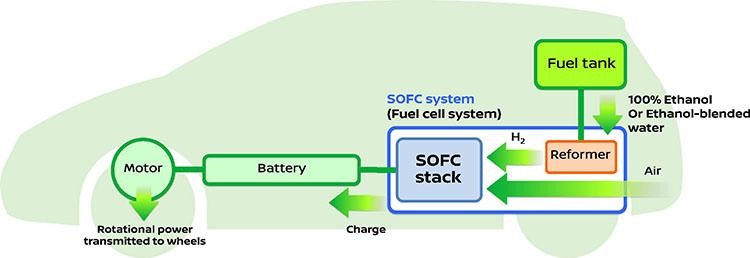Nissan's 2020 Fuel-Cell Plans Put Bio-Ethanol In The Tank
Nissan is getting into the fuel-cell car business, but unlike rivals like Toyota and Honda, it's not looking to hydrogen to power its environmentally-friendly vehicle. Instead, Nissan is looking to harness bio-ethanol electric power, using a range of different fuels – including some sourced from sugarcane or corn – to power an electric car.
It's called an e-Bio Fuel Cell, and it relies on what's known as an SOFC or Solid Oxide Fuel-Cell that offers far greater fuel-type flexibility than the hydrogen-only requirement for Toyota's Mirai or Honda's Clarity.
Bio-ethanol – which can be created by a variety of methods – is combined with air in a "reformer", and the resulting hydrogen is fed to the SOFC stack. That in turn creates electricity, which is used to power electric motors that actually drive the car.
For the driver, Nissan says, the experience behind the wheel is much akin to any other electric vehicle: instantaneous torque and near-silent operation.

However, the company also claims that range on a full tank of fuel is more akin to a gasoline-powered car, working out to over 370 miles. During that time you'll be emitting carbon dioxide, but Nissan says that the CO2 taken in by the crops from which the bio-ethanol is created as they grow will offset that.
Deployments of hydrogen fuel-cell cars have been conservative so far, not least because of the relative paucity of places to actually fill up the tank. Though Toyota and Honda boast that refueling their respective vehicles takes around five minutes for roughly enough fuel for 300 miles of driving – comparable to how long it takes to fill up a traditional gas-powered car – that requires actually finding a place selling hydrogen first.
In contrast, Nissan argues, ethanol-blended water is safer and more straightforward to handle than most other fuels. That means, even though there'd be new infrastructure required to handle SOFC-equipped vehicles, it should be a little easier than for rival fuel types.
Similarly, the high-pressure tanks the Mirai and Clarity require to safely store hydrogen within each car would also no longer be required, given the hydrogen is produced on-demand from a fuel that, at normal atmospheric pressure, is liquid.
NOW READ: Driving Honda's fuel-cell car
Right now, SOFC technology is still in the development stage – Nissan says it's still researching the process – but it could be commercialized by 2020. At this point, though it's not clear how much a vehicle using the technology could end up costing when it turns up on dealer forecourts.
All the same, as a more environmentally sustainable option, the company seems confident that it has an edge over other alternative fuels.
